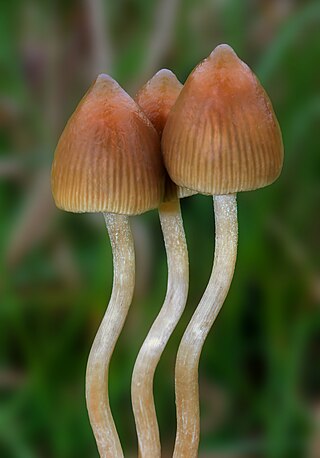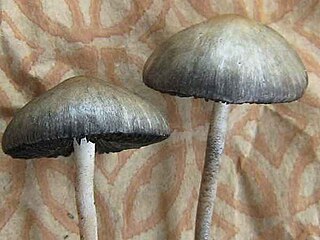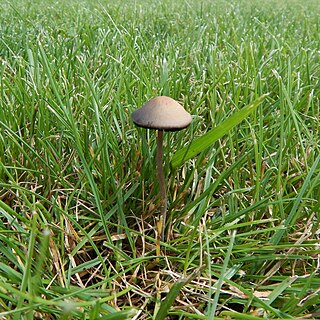
Psilocybin is a naturally occurring psychedelic prodrug compound produced by more than 200 species of fungi. The most potent are members of genus Psilocybe, such as P. azurescens, P. semilanceata, and P. cyanescens, but psilocybin has also been isolated from about a dozen other genera. Psilocybin is itself biologically inactive but is quickly converted by the body to psilocin, which has mind-altering effects similar, in some aspects, to those of lysergic acid diethylamide (LSD), mescaline, and dimethyltryptamine (DMT). In general, the effects include euphoria, visual and mental hallucinations, changes in perception, distorted sense of time, and perceived spiritual experiences. It can also cause adverse reactions such as nausea and panic attacks.

Psilocybe cubensis, commonly known as the magic mushroom, shroom, golden halo, cube, or gold cap, is a species of psilocybin mushroom of moderate potency whose principal active compounds are psilocybin and psilocin. It belongs to the fungus family Hymenogastraceae and was previously known as Stropharia cubensis. It is the best-known psilocybin mushroom due to its wide distribution and ease of cultivation. This mushroom being optimal for home cultivation specifically, as was suggested in the 1970s, is primarily what led to P. cubensis being the psilocybin mushroom species most common on the black market as a street drug.

Psilocybin mushrooms, commonly known as magic mushrooms or shrooms, are a polyphyletic informal group of fungi that contain psilocybin, which turns into psilocin upon ingestion. Biological genera containing psilocybin mushrooms include Psilocybe, Panaeolus, Inocybe, Pluteus, Gymnopilus, and Pholiotina.

Psilocybe is a genus of gilled mushrooms, growing worldwide, in the family Hymenogastraceae. Many species contain the psychedelic compounds psilocybin and psilocin.

Psilocybe semilanceata, commonly known as the liberty cap, is a species of fungus which produces the psychoactive compounds psilocybin, psilocin and baeocystin. It is both one of the most widely distributed psilocybin mushrooms in nature, and one of the most potent. The mushrooms have a distinctive conical to bell-shaped cap, up to 2.5 cm (1 in) in diameter, with a small nipple-like protrusion on the top. They are yellow to brown, covered with radial grooves when moist, and fade to a lighter color as they mature. Their stipes tend to be slender and long, and the same color or slightly lighter than the cap. The gill attachment to the stipe is adnexed, and they are initially cream-colored before tinting purple to black as the spores mature. The spores are dark purplish-brown in mass, ellipsoid in shape, and measure 10.5–15 by 6.5–8.5 micrometres.

Baeocystin is a zwitterionic alkaloid and analog of psilocybin. It is found as a minor compound in most psilocybin mushrooms together with psilocybin, norbaeocystin, aeruginascin, and psilocin. Baeocystin is an N-demethylated derivative of psilocybin, and a phosphorylated derivative of 4-HO-NMT (4-hydroxy-N-methyltryptamine). The structures at right illustrate baeocystin in its zwitterionic form.

Panaeolus cinctulus, syn. Panaeolus subbalteatus, commonly known as the banded mottlegill, weed Panaeolus, belted panaeolus, or subbs is a very common, widely distributed psilocybin mushroom. According to American naturalist and mycologist David Arora, Panaeolus cinctulus is the most common psilocybin mushroom in California.

Panaeolus is a genus of small, black-spored, saprotrophic agarics. The word Panaeolus is Greek for "all variegated", alluding to the spotted gills of the mushrooms produced.

Copelandia is a now deprecated genus of mushrooms consisting of at least 12 species. Many American mycologists previously placed members of Panaeolus which stain blue into Copelandia, whilst European mycologists generally used the name Panaeolus instead. Now all mushrooms previously categorised under Copelandia are universally classified in Panaeolus. The genus Copelandia was created as a subgenus of Panaeolus by Abbé Giacomo Bresadola (1847–1929) in honor of Edwin Bingham Copeland (1873–1964), an American who gathered fungi in the Philippines and sent some collections to Bresadola.

Panaeolus cyanescens is a mushroom in the Bolbitiaceae family. Panaeolus cyanescens is a common psychoactive mushroom and is similar to Panaeolus tropicalis.

Panaeolus bisporus, also known as Copelandia bisporus is a rare and widely distributed little brown mushroom that bruises blue and contains the hallucinogen psilocybin.

Panaeolus cambodginiensis is a potent hallucinogenic mushroom that contains psilocybin and psilocin. It was described in 1979 as Copelandia cambodginiensis.

Panaeolus olivaceus is a widely distributed, seldom identified, little brown mushroom that contains the hallucinogen psilocybin; it is often mistaken for Panaeolus foenisecii and is distinguished by its black spore print and darker gill coloration when mature alongside a slightly thicker stem. It is even more easily mistaken for Panaeolus cinctulus or Panaeolus fimicola and can be distinguished from them both by its slightly roughened spores. It is also easily confused with Panaeolina castaneifolia, a species which has spores that are dark brown and significantly more roughened.

Panaeolus fimicola is a widespread but seldom identified "little brown mushroom" which sometimes contains small amounts of the hallucinogen psilocybin. Panaeolus ater is a synonym. The species is also referred to as the "turf mottlegill".

Panaeolus papilionaceus, also known as Agaricus calosus, Panaeolus campanulatus, Panaeolus retirugis, and Panaeolus sphinctrinus, and commonly known as Petticoat mottlegill, is a very common and widely distributed little brown mushroom that feeds on dung.
Conocybe siligineoides, also known as cone caps, Ya'nte, Ta'a'ya, or Tamu, is a species of macro-fungus in the family Bolbitiaceae. It has seldom been observed by the mycological community with all specimens having been collected in Mexico. Originally reported as a sacred mushroom, no chemical studies have been undertaken on this species although other members of the same genus have been shown to contain psilocybin, which causes strong hallucinations. They are crushed, dried, and used in tea, and consumed fresh.
Panaeolus microsporus is a species of mushroom in the Bolbitiaceae family. It is a psychoactive species of the Panaeolus genus, containing alkaloids like psilocybin and psilosin. All Panaeolus species produce serotonin and serotonin derivatives.

Panaeolus rubricaulis is a species of mushroom in the Bolbitiaceae family.
Panaeolus lentisporus is a species of psychoactive mushroom belonging to the genus Panaeolus, and classified under the family Bolbiteacea. It is native to Papua New Guinea and some parts of Asia. The fungus was first described by E. Gerhardt in 1996. It is very similar to Panaeolus affinis, and should not be confused with it.












